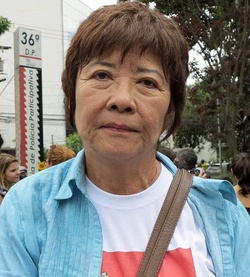マリゲラと共にゲリラ活動=拷問で苦しんだ三宅ダルシ
「軍事クーデター50年・独裁政治の撲滅を」式典が3月31日、聖市南部にある市警36分署の裏、かつて左翼活動家の逮捕や拷問による情報収集と分析を目的とした軍施設のまん前で実施された。千数百人の参加者は、今も行方不明の活動家や拷問死した若者の顔写真を手に、軍政時代の人権侵害の歴史的事実の掘り起こしや、それを特赦したアネスチア法の見直しなどを訴えた。日系犠牲者の顔写真もみられる生々しい歴史の傷跡を取材した。
「私の活動は家族には理解されなかった」―― “都市ゲリラ戦の教祖” カルロス・マリゲラ率いる武装組織ALN(全国解放行動)でゲリラ活動に参加していた三宅ダルシさん(68、二世)は、そう悔しそうに語った。
当時USP法学部のエリート学生だった三宅さんは、72年1月25日にグアナバラ(リオ)で陸軍DOI―Codi(以下DCと略)に捕まり、28日に聖市のOBAN本部に連れてこられた。まだ27歳だった。
三宅さんは「私は逮捕状もないまま、DCに7カ月間も “誘拐監禁” されていた」とすぐ横の建物を指さした。「彼らは私から情報を聞き出そうと1カ月間、毎日拷問したのよ。その後は週2回ぐらい。…言葉にならない酷い体験だった」と振り返る。
13年12月12日付けブラジル国営通信記事によれば、同日の連邦真相究明委員会で三宅さんは、自分を拷問した暗号名 “ウビラジャラ大尉” が目の前にいるアパレシード・ラエルテス・カランドラ元市警捜査官に間違いないと断定し、「私は、彼やその部下から耳、足や手、女性器まで電気ショックで拷問されて苦しんだ。彼は仲間の多くの殺害に関わったはず」と証言をした。
64年の軍政開始時から検討されてきた左翼活動抑圧の「バンデイランテス作戦」(OBAN)の開始は、軍政を人権侵害の次なる段階に導いた作戦と言われる。政治社会警察(DOPS)と連邦警察、市警、公安部隊の左翼取締り関連部署による合同作戦として69年7月に始まった。
第23回国家歴史シンポ(05年)で発表されたUSPのマリアナ・ランジェル・ジョフィリ論文によれば、この作戦を資金面で支援したのはウルトラ・グループ、フォード、ゼネラル・モータース等の多国籍企業群だった。
PBANの経験を元に翌70年7月に軍直轄の常設組織として、同様のメンバーからなる情報作戦本部(DOI)と治安行動センター(Codi)が設置された。前者が作戦行動の指揮かつ捜索・逮捕・尋問、後者が情報分析・軍各部署との連携調整を担当した。
多くの拷問犠牲者が “ウビラジャラ大尉” は同氏に間違いない証言していることに関し、同捜査官は同委員会で「まったく身に覚えがない。拷問など人権侵害に関わったことはない」と関与を真っ向から否定した。
クルツーラTV局の幹部ヴラジミル・エルゾキさんら数々のジャーナリストや活動家が拷問の末に “行方不明” もしくは “病死” や “自殺“ したとされている建物は、イベントの喧騒をよそに、不気味な静けさをたたえていた。
※ 本稿はブラジルの邦字紙『ニッケイ新聞』(2014年4月5日)から、許可を持って転載しています。
© 2014 Nikkey Shimbun







